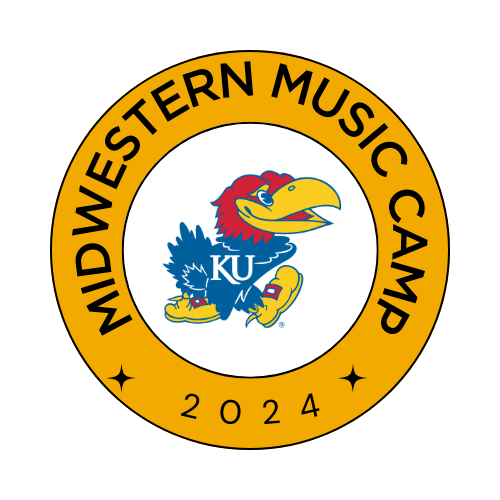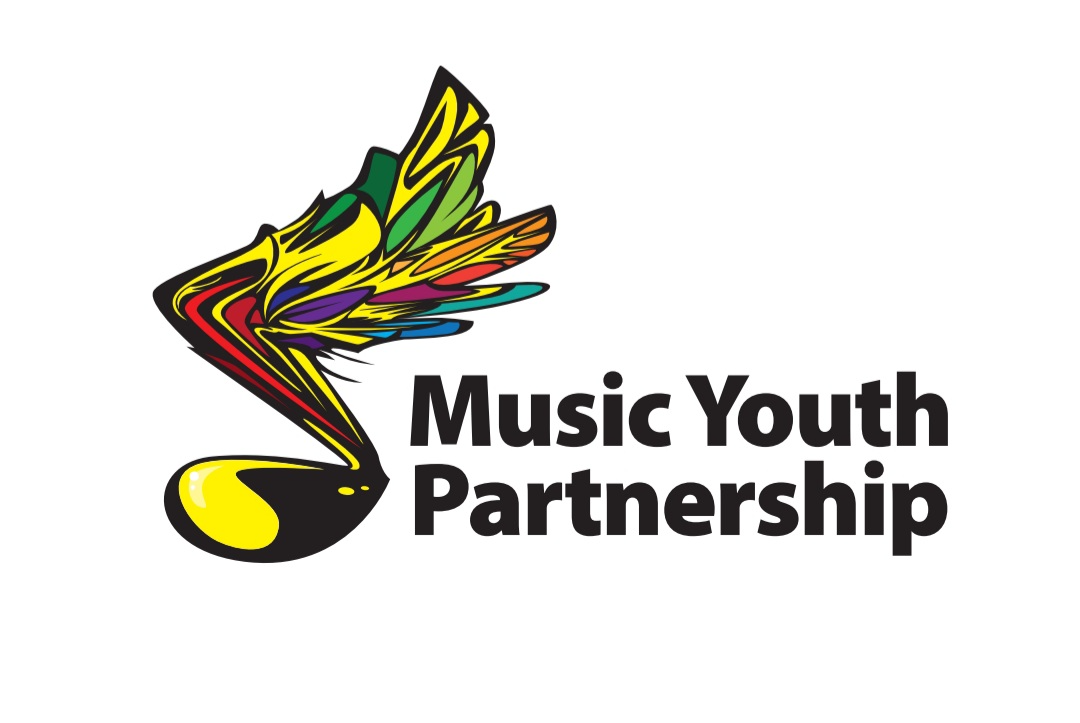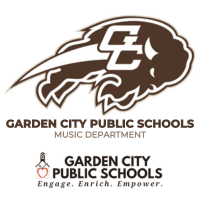
The 2014 National Core Music Standards are a great resource for those striving to be educators who teach music comprehensively through performance in large ensemble. Written for music educators, by music educators, these standards encourage students to do, think, feel, and understand music through the Three Artistic Processes of Creating, Performing, and Responding. Built for ultimate flexibility, these standards are presented in a grade by grade sequence from PK through 8 and in different strands (composition/theory, music technology, guitar/keyboard/harmonizing instruments, ensemble) with proficiency divisions at the secondary level (novice, intermediate, proficient, accomplished, advanced). More information about the 2014 Music Standards can be found on the National Association for Music Education website at http://www.nafme.org/my-classroom/standards/.
Employing these standards in a traditional large ensemble can seem like a daunting task. Teaching students how to be independent musicians instead of just teaching them to be concert ready may require a new outlook on unit and lesson planning. To aid in this shift, Model Cornerstone Assessments have been released in conjunction with the standards. These Model Cornerstone Assessments contain complete units that can be used to teach holistically using the 2014 Music Standards. There are sample units for all of the different strands at all of the proficiency divisions. More information about the Music Model Cornerstone Assessments can be found at http://www.nafme.org/my-classroom/standards/mcas-information-on-taking-part-in-the-field-testing/.
For those who want to incorporate the 2014 Music Standards into their large ensembles but cannot currently devote the time it would take to fully implement a Model Cornerstone Assessment, there are other methods. Below are a few ways to get your large ensemble students Creating, Performing, and Responding!
Creating
Choose Repertoire Incorporating Aleatoric Sections/ Improvisation Many large ensemble pieces contain small sections that allow students to choose what they want to play or sing within a certain set of composer Instead of just telling students to follow the instructions, spend some rehearsal time discussing the effect the composer is after and having students experiment with different ideas. Let them play or sing as sections or individuals for each other and evaluate the quality of their work. An example of an aleatoric section that might be found in an ensemble piece is below.

Improvise Within a Scale Studies or Warm Ups When introducing or reinforcing scales, add an improvisation component. Have students play or sing using the scale in order to strengthen the concept from a different angle. For example, students could play or sing a motive they invent using the notes of the chosen scale and their classmates could try to play or sing it back to them. This exercise would not only get students improvising but also practicing their ear training, making them better listeners. Rhythmic and pitch content could be limited based on the ensemble’s ability or the focus of the warm up.
Compose Within Scale Studies or Warm ups If students have staff paper or a notebook in their music folder, they can write out melodies or motives using notes of a select scale. They can play or sing their short composition and then switch papers with other students to evaluate, play, or sing. This same exercise could be done using a determined set of rhythmic values, eliminating the pitch element, depending on what the focus of the warm up needed to be. An example of this type of exercise can be found below.
- Write your own melody. It must:
- Be 2 measures long
- Use only half notes, quarter notes, and eighth notes
- Use only the notes of the concert F major scale
- Start and end on concert F
Performing
Let Students Help Determine the Program Talk with students about what makes a high quality piece of music and then give them a voice in music selection. Pick two pieces that meet the objectives for the concert cycle and sight read them both. Spend a bit of time getting to know the pieces for their musical merit and talking with the students about how to select appropriate repertoire. Poll the class as to what they want to play or sing and why from a musical perspective. Some published criteria for high quality music can be found below.
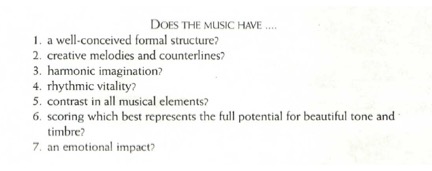
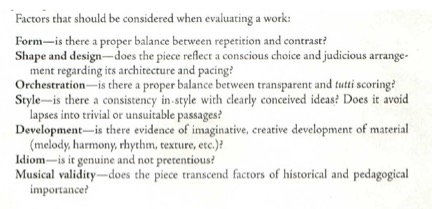
Have Students Evaluate Recordings of Rehearsals/Concerts Make an audio recording of a rehearsal or performance. Have students listen and list things that they have improved upon during the concert cycle and also things that they need to keep working on. Compile everyone’s notes to share with the ensemble or have the students talk in sections about the changes that need to occur.
Ask Students to Critique Rehearsals Choose a passage of music and play or sing it through. At the end of the run, ask the students what they heard that needs to be refined. Students’ listening can be directed by the use of leading questions, established rubrics or priorities, or it can be open response. After a student says what he or she heard, ask for suggestions for improvement. Make sure to run the passage again with the students making the suggested changes so the effectiveness of the change can be evaluated afterwards. If the teacher wishes to engage all students, instead of those who volunteer, he or she can pose the leading questions as choices. This type of exercise can be repeated with the brass being asked to listen and evaluate the woodwind’s performance or the altos to evaluate the soprano’s. The important thing is that the students in the ensemble have an opportunity to be active in the rehearsing, evaluating, and refining of what they are working on.
Responding
Talk About Feelings Play various genres of music for students and, in addition to asking about what compositional devices they are hearing, ask them how it makes them feel or if they like it or not. Follow up by asking what aspects of the music makes them feel that way. This can be done through discussion or by individual written response.
Let Students Contribute to the Interpretation Listen to various recordings of the music the ensemble is learning or a recording of the ensemble playing or singing a section of a piece in various ways. Discuss or write down which aspects of each recording they like best from an interpretive stand point. Experiment with interpretive ideas from the ensemble and discuss what works and why. Examples of two different interpretations of Clare Grundman’s Kentucky 1800 are below to help illustrate the exercise.
- Kentucky 1800 Example 1
- Kentucky 1800 Example 2
Find Programmatic Elements in the Music When playing or singing a piece of programmatic music have students find the compositional elements that help portray the story or the mood. This can be done through discussion or written response. Ask students what additional interpretive elements could help to communicate the composer’s intent. For added connection, spend some time learning and talking about the subject of the program. This could be an opportunity to collaborate with the other teachers that work in the building.
It is important to note that the National Core Music Standards imbed a fourth Creative Process, Connecting, in the categories above. The authors of the standards felt that connecting music to personal experience, the arts, and the other core subjects is intertwined when Creating, Performing, and Responding. The National Core Arts Standards, for which the National Core Music Standards are related, consider Connecting a stand alone process.
Even though some of the above activities do not directly involve students playing their instruments or using their voices, all of the above activities contribute to the total musicianship of the student. While these suggestions may take some time away from woodshedding a particular piece during a concert cycle, they will yield results that help students become thoughtful consumers and producers of music well into the future. Students should leave their large ensemble classrooms not just with the ability to play or sing the pieces they performed while a member of their bands and choirs but also with the tools and knowledge to create, perform, and respond to music in a multitude of ways as university students, working adults, and as citizens of a musical world.
“Give a man a fish and you feed him for a day.
Teach him how to fish and you feed him for a lifetime.” — Lao Tzu
Resources
National Core Arts Standards. (n.d.). Retrieved July 26, 2016, from http://www.nationalartsstandards.org/
Standards – National Association for Music Education (NAfME). (n.d.). Retrieved July 26, 2016, from http://www.nafme.org/my-classroom/standards/
Cramer, Ray. Teaching Music Through Performance in Band. Chicago: GIA Publications, 1997.
Battisti, Frank. On Becoming a Conductor: Lessons and Mediations on the Art of Conducting. Galesville, MD: Meredith Music, 2007.
Sarah Labovitz is currently the Associate Director of Bands and Coordinator of Instrumental Music Education at Arkansas State University. She directs the Symphonic Winds, teaches instrumental music education and conducting, and supervises student teachers. Prior to her appointment at A-State, Dr. Labovitz served as the Assistant Director of Bands at Washburn University. She has a BME from Bowling Green State University, a MME from Indiana University and a DMA in Wind Conducting from the University of Kansas.
Dr. Labovitz is an active guest conductor and clinician, as well as a contributing author to the Teaching Music Through Performance in Band series. Her public school experience includes serving as Director of Bands at Athens High School in Athens, OH and Director of Instrumental Music at Admiral King High School in Lorain, OH.








